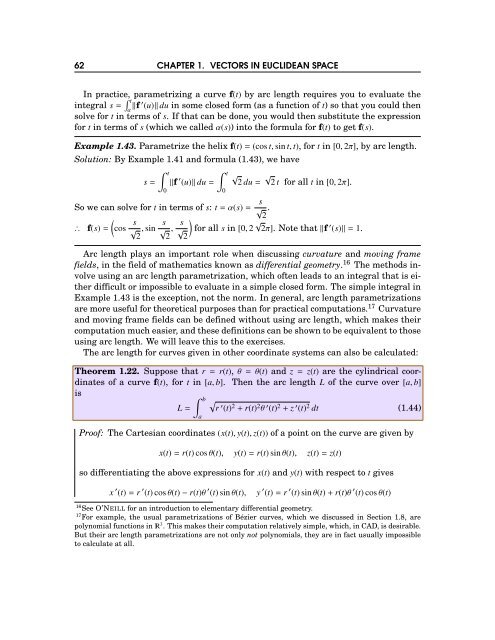Michael Corral: Vector Calculus
Michael Corral: Vector Calculus
Michael Corral: Vector Calculus
You also want an ePaper? Increase the reach of your titles
YUMPU automatically turns print PDFs into web optimized ePapers that Google loves.
62 CHAPTER 1. VECTORS IN EUCLIDEAN SPACE<br />
In practice, parametrizing a curve f(t) by arc length requires you to evaluate the<br />
integral s= ∫ t<br />
a ‖f′ (u)‖du in some closed form (as a function of t) so that you could then<br />
solve for t in terms of s. If that can be done, you would then substitute the expression<br />
for t in terms of s (which we calledα(s)) into the formula for f(t) to get f(s).<br />
Example 1.43. Parametrize the helix f(t)=(cost,sint,t), for t in [0,2π], by arc length.<br />
Solution: By Example 1.41 and formula (1.43), we have<br />
s=<br />
∫ t<br />
0<br />
‖f ′ (u)‖du=<br />
∫ t<br />
0<br />
√<br />
2du=<br />
√<br />
2t for all t in [0,2π].<br />
So we can solve for t in terms of s: t=α(s)= √ s .<br />
(<br />
2<br />
s<br />
∴ f(s)= cos√ ,sin s s<br />
)<br />
√ , √ for all s in [0,2 √ 2π]. Note that‖f ′ (s)‖=1.<br />
2 2 2<br />
Arc length plays an important role when discussing curvature and moving frame<br />
fields, in the field of mathematics known as differential geometry. 16 The methods involve<br />
using an arc length parametrization, which often leads to an integral that is either<br />
difficult or impossible to evaluate in a simple closed form. The simple integral in<br />
Example 1.43 is the exception, not the norm. In general, arc length parametrizations<br />
are moreusefulfor theoreticalpurposesthanfor practical computations. 17 Curvature<br />
and moving frame fields can be defined without using arc length, which makes their<br />
computationmucheasier,andthesedefinitionscanbeshowntobeequivalenttothose<br />
using arc length. We will leave this to the exercises.<br />
The arc length for curves given in other coordinate systems can also be calculated:<br />
Theorem 1.22. Suppose that r=r(t),θ=θ(t) and z=z(t) are the cylindrical coordinates<br />
of a curve f(t), for t in [a,b]. Then the arc length L of the curve over [a,b]<br />
is ∫ b √<br />
L= r ′ (t) 2 +r(t) 2 θ ′ (t) 2 +z ′ (t) 2 dt (1.44)<br />
a<br />
Proof: The Cartesian coordinates (x(t),y(t),z(t)) of a point on the curve are given by<br />
x(t)=r(t)cosθ(t), y(t)=r(t)sinθ(t), z(t)=z(t)<br />
so differentiating the above expressions for x(t) and y(t) with respect to t gives<br />
x ′ (t)=r ′ (t)cosθ(t)−r(t)θ ′ (t)sinθ(t), y ′ (t)=r ′ (t)sinθ(t)+r(t)θ ′ (t)cosθ(t)<br />
16 See O’NEILL for an introduction to elementary differential geometry.<br />
17 For example, the usual parametrizations of Bézier curves, which we discussed in Section 1.8, are<br />
polynomialfunctionsin 3 . Thismakestheircomputationrelativelysimple, which, inCAD,isdesirable.<br />
But their arc length parametrizations are not only not polynomials, they are in fact usually impossible<br />
to calculate at all.








